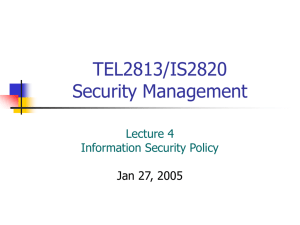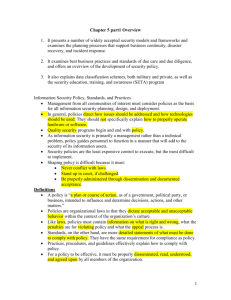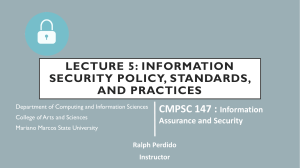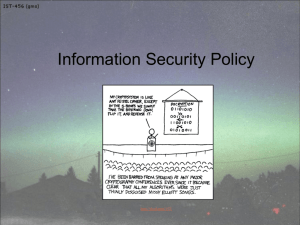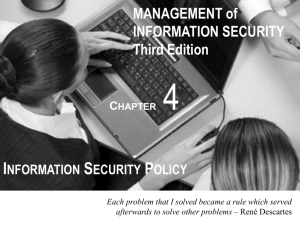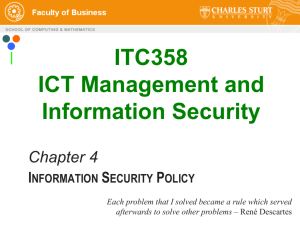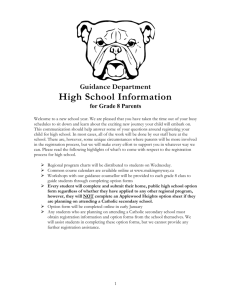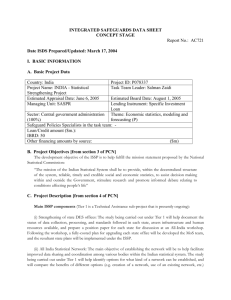Chapter 1
advertisement
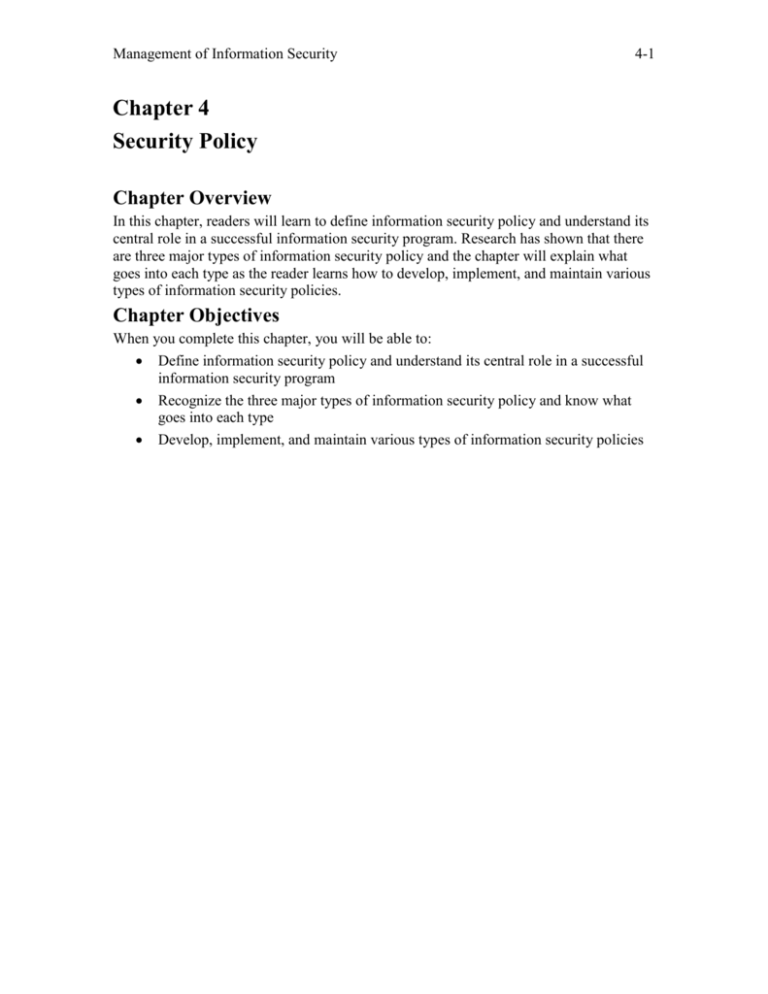
Management of Information Security 4-1 Chapter 4 Security Policy Chapter Overview In this chapter, readers will learn to define information security policy and understand its central role in a successful information security program. Research has shown that there are three major types of information security policy and the chapter will explain what goes into each type as the reader learns how to develop, implement, and maintain various types of information security policies. Chapter Objectives When you complete this chapter, you will be able to: Define information security policy and understand its central role in a successful information security program Recognize the three major types of information security policy and know what goes into each type Develop, implement, and maintain various types of information security policies Management of Information Security 4-2 Introduction This chapter focuses on information security policy: what it is, how to write it, how to implement it, and how to maintain it. Policy is the essential foundation of an effective information security program. “The success of an information resources protection program depends on the policy generated, and on the attitude of management toward securing information on automated systems. You, the policy maker, set the tone and the emphasis on how important a role information security will have within your agency. Your primary responsibility is to set the information resource security policy for the organization with the objectives of reduced risk, compliance with laws and regulations and assurance of operational continuity, information integrity, and confidentiality.” Why Policy? A quality information security program begins and ends with policy. Properly developed and implemented policies enable the information security program to function almost seamlessly within the workplace. Although information security policies are the least expensive means of control to execute, they are often the most difficult to implement. Some basic rules must be followed when shaping a policy: Policy should never conflict with law Policy must be able to stand up in court, if challenged Policy must be properly supported and administered “All policies must contribute to the success of the organization. Management must ensure the adequate sharing of responsibility for proper use of information systems. End users of information systems should be involved in the steps of policy formulation.” The Bulls-eye Model Bulls-eye model layers: Policies—the outer layer in the bull’s-eye diagram Networks—where threats from public networks meet the organization’s networking infrastructure Systems—includes computers used as servers, desktop computers, and systems used for process control and manufacturing systems Applications—includes all applications systems Management of Information Security 4-3 “…policies are important reference documents for internal audits and for the resolution of legal disputes about management's due diligence [and] policy documents can act as a clear statement of management's intent…” Policy, Standards, and Practices Policy is “a plan or course of action, as of a government, political party, or business, intended to influence and determine decisions, actions, and other matters”. A standard is a more detailed statement of what must be done to comply with policy. Practices, procedures and guidelines explain how employees will comply with policy. Management of Information Security 4-4 For policies to be effective they must be: properly disseminated read understood agreed-to Policies require constant modification and maintenance. In order to produce a complete information security policy, management must define three types of information security policy: Enterprise information security program policy Issue-specific information security policies Systems-specific information security policies Enterprise Information Security Policy …sets the strategic direction, scope, and tone for all of an organization’s security efforts. … assigns responsibilities for the various areas of information security. … guides the development, implementation, and management requirements of the information security program. EISP Elements Most EISP documents should provide: An overview of the corporate philosophy on security Information on the structure of the information security organization and individuals that fulfill the information security role Fully articulated responsibilities for security that are shared by all members of the organization Fully articulated responsibilities for security that are unique to each role within the organization Components of the EISP Statement of Purpose - Answers the question “What is this policy for?” Provides a framework for the helps the reader to understand the intent of the document. Information Technology Security Elements - Defines information security. Need for Information Technology Security - Provides information on the importance of information security in the organization and the obligation (legal and ethical) to protect critical information whether regarding customers, employees, or markets. Information Technology Security Responsibilities and Roles - Defines the organizational structure designed to support information security within the organization. Reference to Other Information Technology Standards and Guidelines - Outlines lists of other standards that influence and are influenced by this policy document. Management of Information Security 4-5 Example EISP - CCW Protection of Information: Information must be protected in a manner commensurate with its sensitivity, value, and criticality. Use of Information: Company X information must be used only for the business purposes expressly authorized by management. Information Handling, Access, and And Usage: Information is a vital asset and all accesses to, uses of, and processing of, Company X information must be consistent with policies and standards. Data and Program Damage Disclaimers: Company X disclaims any responsibility for loss or damage to data or software that results from its efforts to protect the confidentiality, integrity, and availability of the information handled by computers and communications systems. Legal Conflicts: Company X information security policies were drafted to meet or exceed the protections found in existing laws and regulations, and any Company X information security policy believed to be in conflict with existing laws or regulations must be promptly reported to Information Security management. Exceptions to Policies: Exceptions to information security policies exist in rare instances where a risk assessment examining the implications of being out of compliance has been performed, where a standard risk acceptance form has been prepared by the data Owner or management, and where this form has been approved by both Information Security management and Internal Audit management. Policy Non-Enforcement: Management's non-enforcement of any policy requirement does not constitute its consent. Violation of Law: Company X management must seriously consider prosecution for all known violations of the law. Revocation of Access Privileges: Company X reserves the right to revoke a user's information technology privileges at any time. Industry-Specific Information Security Standards: Company X information systems must employ industry-specific information security standards. Use of Information Security Policies and Procedures: All Company X information security documentation including, but not limited to, policies, standards, and procedures, must be classified as “Internal Use Only,” unless expressly created for external business processes or partners. Security Controls Enforceability: All information systems security controls must be enforceable prior to being adopted as a part of standard operating procedure. Issue-Specific Security Policy A sound issue-specific security policy provides detailed, targeted guidance to instruct all members of the organization in the use of technology based systems. Management of Information Security 4-6 The ISSP should begin with an introduction of the fundamental technological philosophy of the organization. This serves to protect both the employee and the organization from inefficiency and ambiguity. An effective ISSP: Articulates the organization’s expectations about how the technology-based system in question should be used Documents how the technology-based system is controlled and identifies the processes and authorities that provide this control Serves to indemnify the organization against liability for an employee’s inappropriate or illegal system use Every organization’s ISSP should: Address specific technology-based systems Require frequent updates Contain an issue statement on the organization’s position on an issue. ISSP topics could include: Electronic mail Use of the Internet and the World Wide Web Specific minimum configurations of computers to defend against worms and viruses Prohibitions against hacking or testing organization security controls Home use of company-owned computer equipment Use of personal equipment on company networks Use of telecommunications technologies Use of photocopy equipment Components of the ISSP Statement of Purpose o Scope and Applicability o Definition of Technology Addressed o Responsibilities Authorized Access and Usage of Equipment o User Access o Fair and Responsible Use o Protection of Privacy Prohibited Usage of Equipment o Disruptive Use or Misuse o Criminal Use Management of Information Security o Offensive or Harassing Materials o Copyrighted, Licensed or other Intellectual Property o Other Restrictions Systems Management o Management of Stored Materials o Employer Monitoring o Virus Protection o Physical Security o Encryption Violations of Policy o Procedures for Reporting Violations o Penalties for Violations Policy Review and Modification o Scheduled Review of Policy o Procedures for Modification Limitations of Liability o Statements of Liability o Other Disclaimers 4-7 Management of Information Security 4-8 Implementing ISSP Common approaches for creating and managing ISSPs include: Create a number of independent ISSP documents, each tailored to a specific issue Create a single comprehensive ISSP document that aims to cover all issues Create a modular ISSP document that unifies policy creation and administration, while maintaining each specific issue’s requirements. Management of Information Security 4-9 The recommended approach is the modular policy, which provides a balance between issue orientation and policy management. System-Specific Policy Systems-Specific Policies (SysSPs) frequently do not look like other types of policy. They may often be created to function as standards or procedures to be used when configuring or maintaining systems. SysSPs can be separated into two general groups, management guidance and technical specifications, or they may be written like the example noted above to combine these two types of SysSP content into a single policy document. Management of Information Security 4-10 Management Guidance SysSPs Created by management to guide the implementation and configuration of technology as well as address the behavior of people in the organization in ways that support the security of information. Any technology that affects the confidentiality, integrity or availability of information must be assessed to evaluate the tradeoff between improved security and restrictions. Before management can craft a policy informing users what they can do with the technology and how they may do it, it might be necessary for system administrators to configure and operate the system. Technical Specifications SysSPs While a manager may work with a systems administrator to create managerial policy as specified above, the system administrator may need to create a different type of policy to implement the managerial policy. Each type of equipment has its own type of policies, which are used to translate the management intent for the technical control into an enforceable technical approach. There are two general methods of implementing such technical controls, access control lists and configuration rules. Access Control Lists Access control lists (ACLs) include the user access lists, matrices, and capability tables that govern the rights and privileges of users. ACLs can control access to file storage systems, object brokers or other network communications devices. A capability table is a similar method that specifies which subjects and objects users or groups can access. It clearly identifies which privileges are to be granted to each user or group of users. Management of Information Security 4-11 These specifications are frequently complex matrices, rather than simple lists or tables. The level of detail and specificity (often called granularity) may vary from system to system, but in general ACLs enable administrations to restrict access according to user, computer, time, duration, or even a particular file. In general ACLs regulate: Who can use the system What authorized users can access When authorized users can access the system Where authorized users can access the system from How authorized users can access the system Restricting what users can access, e.g. printers, files, communications, and applications. Administrators set user privileges, such as: Read Write Create Modify Delete Compare Copy In some systems, capability tables are called user profiles or user policies. Configuration Rules Management of Information Security 4-12 Configuration rules are the specific configuration codes entered into security systems to guide the execution of the system when information is passing through it. Rule policies are more specific to the operation of a system than ACLs, and may or may not deal with users directly. Many security systems require specific configuration scripts telling the systems what actions to perform on each set of information they process. Management of Information Security 4-13 Combination SysSPs It is not uncommon for an organization to create a single document that combines elements of both the Management Guidance and the Technical Specifications SysSPs. While this can be somewhat confusing to those who will use the policies, it is very practical to have the guidance from both perspectives in a single place. Care should be taken to articulate the required actions carefully as the procedures are presented. Guidelines for Policy Development It is often useful to view policy development as a two-part project. The first project designs and develops the policy (or redesigns and rewrites an outdated policy), and the second establishes management processes to perpetuate the policy within the organization. The former is an exercise in project management, while the latter requires adherence to good business practices. The Policy Project Management of Information Security 4-14 Like any IT project, a policy development or re-development project should be well planned, properly funded, and aggressively managed to ensure that it is completed on time and within budget. When a policy development project is undertaken, the project can be guided by the SecSDLC process. Investigation Phase During the Investigation phase the policy development team should complete the following activities: Obtain support from senior management Support and active involvement of IT management, specifically the CIO. The clear articulation of goals The participation of the correct individuals from the communities of interest affected by the recommended policies. The team must include representatives from Legal, Human Resources and endusers of the various IT systems covered by the policies. The team will need a project champion with sufficient stature and prestige to accomplish the goals of the project. The team will also need a capable project manager to see the project through to completion. A detailed outline of the scope of the policy development project, and sound estimates for the cost and scheduling of the project. Analysis Phase The Analysis phase should include the following activities: A new or recent risk assessment or IT audit documenting the current information security needs of the organization. The gathering of many key reference materials—including any existing policies— in addition to the items noted above. Design Phase The Design phase should include the following activities: A design and plan for how the policies will be distributed and how verification of the distribution to members of the organization will be accomplished. Specifications for any automated tool used for the creation and management of policy documents. Revisions to feasibility analysis reports based on improved costs and benefits as the design is clarified. Implementation Phase In the Implementation phase the policy development team will see to the writing the policies. Resources available include: The Web Management of Information Security 4-15 Government sites Professional literature. Several authors Peer networks. Professional consultants. Make certain the policies are enforceable. Policy distribution is not always as straightforward as you might think. Effective policy is written at a reasonable reading level, and attempts to minimize technical jargon and management terminology. Management of Information Security 4-16 Maintenance Phase During the maintenance phase, the policy development team monitors, maintains, and modifies the policy as needed to ensure that it remains effective as a tool to meet changing threats. The policy should have a built-in mechanism via which users can report problems with the policy, preferably anonymously. The Information Security Policy Made Easy Approach (ISPME) Gathering Key Reference Materials Defining A Framework For Policies Preparing A Coverage Matrix Making Critical Systems Design Decisions Structuring Review, Approval, And Enforcement Processes ISPME Checklist Perform a risk assessment or information technology audit to determine your organization's unique information security needs. Clarify what the word “policy” means within your organization so that you are not preparing a “standard,” “procedure,” or some other related material. Ensure that roles and responsibilities related to information security are clarified, including responsibility for issuing and maintaining policies. Convince management that it is advisable to have documented information security policies. Identify the top management staff who will be approving the final information security document and all influential reviewers. Collect and read all existing internal information security awareness material and make a list of the included bottom-line messages. Management of Information Security 4-17 Conduct a brief internal survey to gather ideas that stakeholders believe should be included in a new or updated information security policy. Examine other policies issued by your organization such as those from Human Resources management, to identify prevailing format, style, tone, length, and cross-references. Identify the audience to receive information security policy materials and determine whether they will each get a separate document or a separate page on an intranet site. Determine the extent to which the audience is literate, computer knowledgeable, and receptive to security messages. Decide whether some other awareness efforts must take place before information security policies are issued. Using ideas from the risk assessment, prepare a list of absolutely essential policy messages that must be communicated. If there is more than one audience, match the audiences with the bottom-line messages to be communicated through a coverage matrix. […] Determine how the policy material will be disseminated, noting the constraints and implications of each medium of communication. Review the compliance checking process, disciplinary process, and enforcement process to ensure that they all can work smoothly with the new policy document. Determine whether the number of messages is too large to be handled all at one time, and if so, identify different categories of material that will be issued at different times. Have an outline of topics to be included in the first document reviewed by several stakeholders. Based on comments from the stakeholders, revise the initial outline and prepare a first draft […] Have the first draft document reviewed by the stakeholders for initial reactions, presentation suggestions, and implementation ideas. Revise the draft in response to comments from stakeholders. Request top management approval on the policy. Prepare extracts of the policy document for selected purposes. Develop an awareness plan that uses the policy document as a source of ideas and requirements. Create a working papers memo indicating the disposition of all comments received from reviewers, even if no changes were made. Write a memo about the project, what you learned, and what needs to be fixed so that the next version of the policy document can be prepared more efficiently, better received by the readers, and more responsive to the unique circumstances facing your organization. Management of Information Security 4-18 Prepare a list of next steps that will be required to implement the requirements specified in the policy document. ISPME Next Steps Post Polices To Intranet Or Equivalent Develop A Self-Assessment Questionnaire Develop Revised user ID Issuance Form Develop Agreement To Comply With Information Security Policies Form Develop Tests To Determine If Workers Understand Policies Assign Information Security Coordinators Train Information Security Coordinators Prepare And Deliver A Basic Information Security Training Course Develop Application Specific Information Security Policies Develop A Conceptual Hierarchy Of Information Security Requirements Assign Information Ownership And Custodianship Establish An Information Security Management Committee Develop An Information Security Architecture Document SP 800-18: Guide for Developing Security Plans The NIST Special Publication 800-18 offers another approach to policy management. Because policies are living documents that constantly change and grow. These documents must be properly disseminated (distributed, read, understood and agreed to), and managed. Good management practices for policy development and maintenance make for a more resilient organization. In order to remain current and viable, policies must have: an individual responsible for reviews, a schedule of reviews, a method for making recommendations for reviews, and an indication of policy and revision date. A Final Note on Policy Lest you believe that the only reason to have policies is to avoid litigation, it is important to emphasize the preventative nature of policy. Policies exist first, and foremost, to inform employees of what is and is not acceptable behavior in the organization. This is an effort to improve employee productivity, and prevent potentially embarrassing situations. If the organization could not verify that the employee was in fact properly educated on the policy, as described earlier in the chapter, the employee could sue the organization for wrongful termination. Management of Information Security 4-19 Lawsuits cost money, and the organization could be so financially devastated that it had to go out of business. Other employees lose their livelihood, and no one wins. Discussion Topics 1. Have students perform research on the Internet about Charles Cresson Wood. How many books are available from him and what are their titles? Are they current (when were they published) and do other experts agree that he is an authority on information security policy? 2. Find the EISP for the state government in which you reside. How is it the same or different from the EISP recommended by this textbook? Key Terms Bull’s eye model Practice Procedure Guideline Standard Policy Enterprise information security policy (EISP) Issue-specific security policy (ISSP) System-specific policy (SysSP) Due diligence Principles of Information Security 1-20
